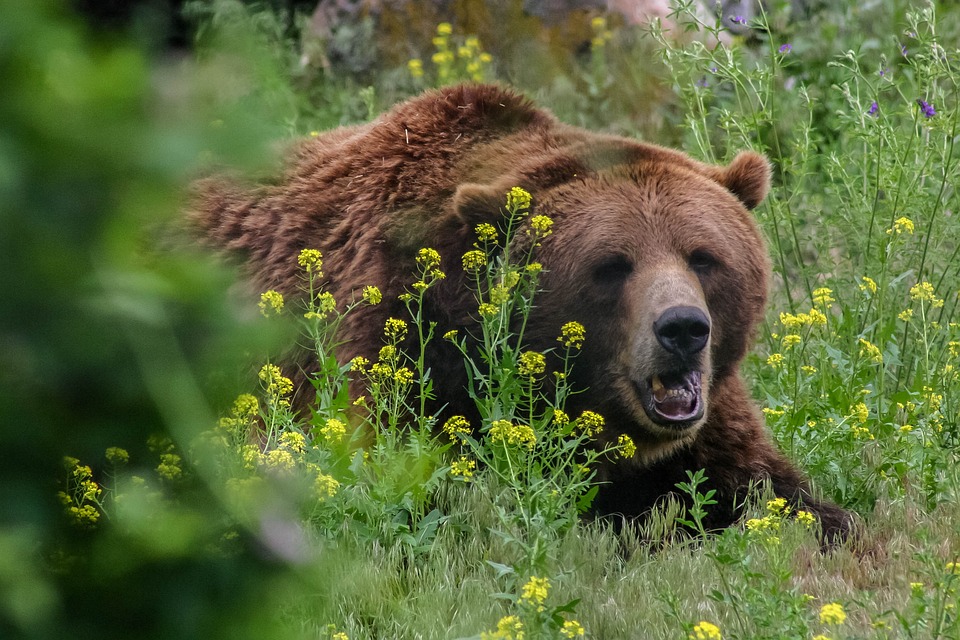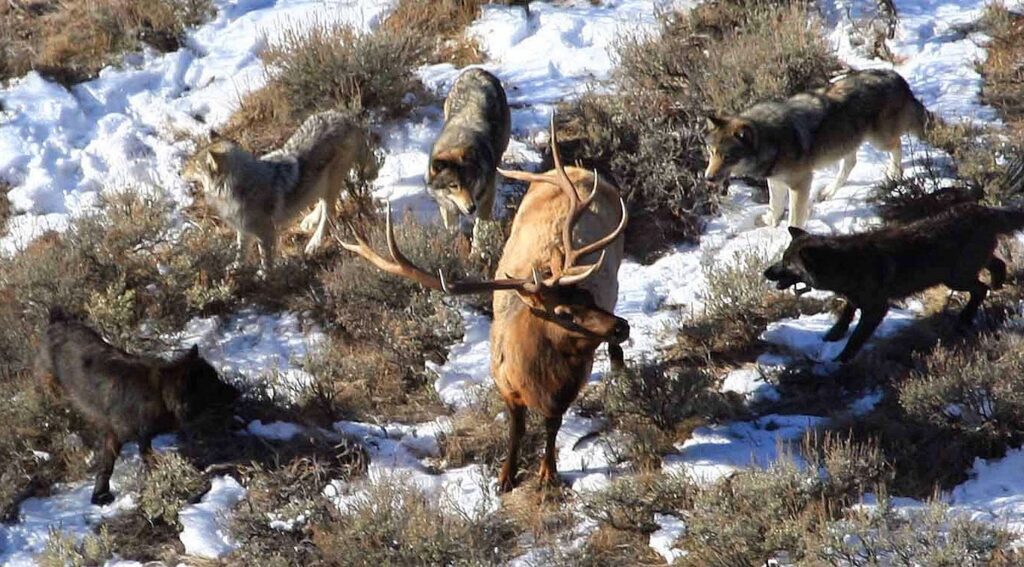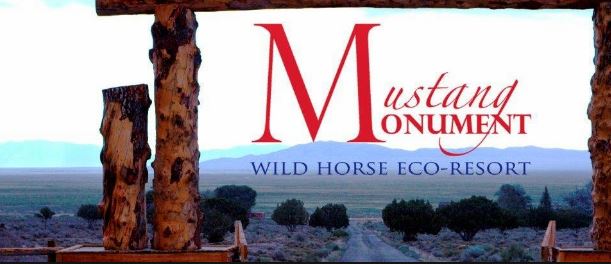‘Yellowstone’ and the Endangered Species Act
Incentives for species recovery need more carrot and less stick

This special edition of PERC Reports uses the hit television show “Yellowstone’s” portrayals of the Rocky Mountain West to examine real-world western issues. Explore the full issue here.
Near the end of “Yellowstone” Season 1 (Episode 7), John Dutton catches a busload of tourists trespassing on his property to photograph a grizzly bear. After shooing away the tourists with his rifle, Dutton sends his cowboys to do the same to the grizzly to protect his cattle.
While tracking the bear later, one of the cowboys, Rip Wheeler, discovers two tourists clinging to the side of a cliff to elude the bear. Wheeler attempts to rescue them, unsuccessfully. As the tourists fall to their deaths, the grizzly roars from a few yards away and then charges Wheeler. Fortunately, he is able to reach his rifle and get off a shot before the bear reaches him. Unfortunately for Wheeler, he’s traded one problem for another.
“What a f—ing mess,” says the local sheriff as he assesses the scene in the following episode (Episode 8), clarifying that he means the dead bear, not the dead tourists. The grizzly is listed under the federal Endangered Species Act, which imposes serious penalties on anyone who harms a listed species. “When someone kills a bear,” says the sheriff, “10,000 vegans send letters to their congressmen. You should have buried that thing in a hole before I got here because I ain’t the problem—the feds are!”
“Yellowstone” highlights real anxieties many private landowners feel about the Endangered Species Act and species listed under it. Although most endangered and threatened species depend on private land for habitat or forage, the law makes these animals liabilities for landowners rather than assets. The presence of a listed species can trigger burdensome land-use restrictions, bring unwanted bureaucracy, and reduce property values. Sam Hamilton, a former director of the U.S. Fish and Wildlife Service, summed up the problem well: “The incentives are wrong here. If a rare metal is on my property, the value of my land goes up. But if a rare bird occupies the land, its value disappears.”
Penalizing landowners who accommodate rare species encourages preemptive habitat destruction, not conservation. The effect of the law’s wrong incentives are seen in its results. While fortunately few listed species have gone extinct, a mere 3 percent have recovered over the last half century, and the service has reported that listed populations are more likely to be declining than improving. A reformed Endangered Species Act that respects property rights and rewards private landowners for their role in conserving species would work better for both landowners and wildlife.
The Incentives Are Wrong
Many landowners are like Dutton; they value the natural beauty of their land and want to protect it for generations to come. Landowner surveys consistently reveal supermajorities who feel an obligation to be good stewards. Yet these surveys also show that the same landowners fear intrusive federal regulation, distrust federal agencies, and may even take steps to deter listed species from their land.
A key source of this anxiety is an Endangered Species Act provision that prohibits the “take” of endangered species. The Fish and Wildlife Service has interpreted this prohibition expansively to include ordinary land-use activities that have incidental effects on species or their habitats. Thus, significant consequences accompany any listed species, not just those that prey on livestock, destroy property, or threaten people. (Fortunately for “Yellowstone’s” Wheeler, the Endangered Species Act has a self-defense provision that ultimately protects him.)
Penalizing landowners who accommodate rare species encourages preemptive habitat destruction, not conservation.
The penalties for violating the take prohibition can be severe. Criminal penalties include a one-year prison term, a $50,000 fine, and revocation of any federal permits or leases. For western ranchers, many of whom depend on a mix of private land and public grazing privileges to feed their cattle, this last penalty can threaten multi-generation businesses. Violators of the take prohibition can also face a civil fine exceeding $50,000. And the government can seize through forfeiture property used during the violation.
Because burdensome restrictions follow listed species wherever they go, scholars have long worried that the Endangered Species Act implicitly encourages landowners to “shoot, shovel, and shut up,” an incentive reflected in the sheriff’s comment to Wheeler: “You should have buried that thing in a hole before I got here.”
Take the endangered red-cockaded woodpecker, a species that resides in old-growth pine forests in the Southeast. A 2003 study found that a single colony can preclude the harvest of $200,000 in private timber. However, because the woodpecker requires old-growth forest, landowners can avoid such losses by cutting trees before they mature. The study found that this is exactly what landowners did, accelerating clearcuts on lands close to established woodpecker colonies.
Landowners do not bear the consequences of these perverse incentives alone. Consider the dusky gopher frog, a perilously vulnerable amphibian found only in a few Mississippi ponds. In 2012, the federal government designated 1,544 acres of private forests in Louisiana as critical habitat for the frog, citing the presence of an ephemeral pond, which is one habitat feature the frog requires. There was a problem though. The frog also relies on a certain type of open-canopied longleaf pine forest, which was absent from the property.
The only way for the land to become suitable habitat would be for the landowner to clearcut the land, plant different trees, then perform regular prescribed burns to maintain the forest in the condition the frog prefers. But, instead of giving the landowner an incentive to perform this difficult and costly work, the critical habitat designation penalized him for the pond’s presence. According to the Fish and Wildlife Service, the landowner stood to lose as much as $34 million due to the designation. Rather than encouraging habitat restoration, the critical habitat designation alienated the landowner and spurred a conflict that reached the Supreme Court.
Two-thirds of listed species depend on private land as essential habitat. And the majority of these are “management dependent,” like the dusky gopher frog, meaning that they and their habitat will not persist without active effort by landowners. Consequently, whether private landowners are encouraged to maintain and restore habitat—or discouraged from doing so—significantly determines whether species decline or improve. Restoring dusky gopher frog habitat is difficult work. As PERC research fellow Tate Watkins reported in a prior PERC Reports article (Summer 2018), the Nature Conservancy has been working for more than a decade to restore dusky gopher frog habitat on its land in Mississippi. Even with the benefit of significant resources, scientific expertise, and deep commitment to the project, progress has been slow. After releasing nearly 10,000 frogs over the years, Nature Conservancy staff estimated the population at fewer than 50 frogs. This is significant progress for a critically endangered species, to be sure. But it has come at a cost that few landowners would bear without some reward. As one of the Nature Conservancy employees remarked then, “It’d be cool if private landowners could do something like this and get credit for it—or at least not get penalized for it.”
Providing a Road to Recovery
The Endangered Species Act’s take prohibition is explicitly reserved for endangered species. Congress envisioned it to operate as a last line of defense against extinction. And, in this respect, it has been a success—only 1 percent of listed species have gone extinct. But the act is intended to do more than avoid extinctions. Its other aim is to facilitate species recoveries. And in this respect the law has been a disappointment.
Part of the explanation for this result is that the law has not operated as intended. Congress designed the law so that federal regulatory restrictions would recede as species recovered and grow more stringent if species declined. According to the Senate sponsor of the act, Congress’ intent was that “States . . . [be] encouraged to use their discretion to promote the recovery of threatened species and Federal prohibitions against taking must be absolutely enforced only for those species on the brink of extinction.”
PERC’s 2018 report “Road to Recovery” explained how the Endangered Species Act’s original two-step approach can promote species recovery. Gradually reducing regulatory restrictions as species recover and increasing stringency if species decline would align the incentives of private landowners with the interests of rare species. In effect, the statute’s original design provides both a carrot and a stick. Two-thirds of listed species depend on private land as essential habitat. Consequently, whether private landowners are encouraged to maintain and restore habitat—or discouraged from doing so—significantly determines whether species decline or improve.
In practice, however, the Fish and Wildlife Service has favored the stick too much. In 1975, two years after Congress passed the law, the service issued a regulation known as the blanket 4(d) rule that categorically prohibits take of threatened species. While the service would sometimes depart from this approach for particular species, the general practice has been to regulate threatened species exactly the same as endangered species, which effectively blunts the act’s original two-step approach.
During the Obama administration, however, the service began to shift away from the blanket rule’s approach, departing from its strict prohibitions in favor of less burdensome rules for most threatened species. That implicit shift was formalized in 2019, when the service formally repealed the blanket 4(d) rule, at least prospectively. (Species listed prior to the repeal remain subject to the rule.)
In announcing this reform, agency staff explained that “we anticipate landowners would be incentivized to take actions that would improve the status of endangered species with the possibility of downlisting the species to threatened and potentially receiving regulatory relief in the resulting 4(d) rule. As a result, we believe these measures to increase public awareness, transparency, and predictability will enhance and expedite conservation.”
While it might seem counterintuitive that reducing regulation would encourage species recoveries, consider how the blanket 4(d) rule’s all-or-nothing approach exacerbates the Endangered Species Act’s ingrained perverse incentives. From the perspective of a landowner, there was little reason to invest time, money, and energy in recovering an endangered species. Even if those efforts succeeded, the landowner could expect no benefit when the species’ status was upgraded to threatened. The same burdensome regulations would still be imposed regardless. Indeed, some Fish and Wildlife Service officials have treated such occasions as a non-event, with one dismissing the notion that endangered and threatened are distinct classifications as a “misperception.”





“Premeditated wrongfull death”.
That is a term for an ESA species like a wolf or bear killing any human.
Punitive damages get considerably higher using the afore.
As far as the feds using the guise of esa to lie cheat or steal is wrong.
most any jury sees right thru it.
ah y ork ge